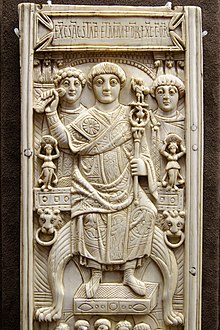Areobindus Dagalaifus Areobindus

Flavius Areobindus Dagalaifus Areobindus[1][2][3] (Greek: Ἀρεόβινδος; fl. 479–512) was an East Roman (Byzantine) general and politician. The scion of a distinguished line, he led troops in the Anastasian War, and served as consul in 506. During an urban riot in 512, he was proclaimed emperor by the mob, but he had gone into hiding. He died soon after.[4]
Origins and family[]
Areobindus was born into an extremely distinguished family, which combined Roman and barbarian heritage:[4] his father was Dagalaifus (c. 430 – after 461), consul in 461, who in turn was the son of Areobindus, consul in 434, both of Gothic origin. His mother was Godisthea (born c. 445), daughter of Ardabur, general and consul in 447, and granddaughter of Aspar, the powerful Alan general and consul in 434.[5]
Shortly after 478, Areobindus married Anicia Juliana (after 461 – 527/528), daughter of the Western Roman emperor Olybrius (r. 472– ) and his wife Placidia. Together they had a son, Olybrius (c. 480 – after 524/527), consul in 491. Another possible descendant is Dagalaiphus (perhaps by an earlier wife).[6]
Career[]
In his consular diptychs, he is listed as having occupied the post of comes sacri stabuli (count of the imperial stable), and as having been accorded the title of an honorary consul.[5] With the outbreak of the Anastasian War, he was sent to the East as magister militum per Orientem along with the praesental magistri Hypatius and Patricius.[5] In May 503, at the head of 12,000 men, he was based at Dara to keep watch at the Persian stronghold of Nisibis and the army of Shah Kavadh I, while Patricius and Hypatius, with the bulk of the army, besieged Amida. There he repelled an attack by a Persian army coming from Singara and pushed them up to Nisibis.[7][8] Eventually however he was compelled to withdraw when the Persians received reinforcements from their Hephthalite and Arab allies, and retreated to Constantia and then to Edessa. He was besieged there by Kavadh in September, but the onset of winter and the approach of Roman reinforcements forced the Persian ruler to withdraw.[7][9] In the summer of 504, Areobindus launched a major raid into Arzanene, meeting little opposition and laying waste to large swathes of land before returning to Amida. With the Roman positions stabilized and the war now being carried over into Persian territory, Kavadh agreed to a truce and hostilities ceased in the winter.[7][10] In 505, he was recalled to Constantinople, where he was awarded the consulship for 506, with Ennodius Messala as his colleague.[7]
In 512, he was living in Constantinople in retirement. At the time, the open advocation of miaphysite doctrines by Emperor Anastasius had caused great anger among the city's mostly Chalcedonian population.[7] At one point, according to the chroniclers, the populace took up the cry "Areobindus for emperor" and marched to the house of his wife, Anicia Juliana, to proclaim him. Areobindus, however, unwilling to take part in a usurpation, had fled the house and gone into hiding. Nothing further is known of him, although, on account of his age, he must have died not long after.[7]
Diptychs[]
| Wikimedia Commons has media related to Areobindus diptych. |
Five examples of his consular diptychs have survived:[4] two complete and three half ones. The two complete ones are located in Lucca (CIL XI, 8137) and Zürich (CIL XIII, 5245); two halves with the name only are located at Paris and Besançon, and a further half with his titles is preserved at Dijon (CIL XIII, 10032, examples .3b, .3d and .3c respectively).[5]
References[]
- ^ Bagnall et al., p. 547.
- ^ Brill's New Pauly, Areobindus 2
- ^ RE Dagalaifus 3
- ^ Jump up to: a b c Kazhdan (1991), p. 162
- ^ Jump up to: a b c d Martindale (1980), p. 143
- ^ Martindale (1980), pp. 143, 635–636, 795
- ^ Jump up to: a b c d e f Martindale (1980), p. 144
- ^ Greatrex & Lieu (2002), p. 68
- ^ Greatrex & Lieu (2002), p. 69
- ^ Greatrex & Lieu (2002), p. 72
Sources[]
- Bagnall, Roger S.; Alan Cameron; Seth R. Schwartz & Klaas A. Worp (1987). Consuls of the Later Roman Empire. Oxford University Press. ISBN 1-55540-099-X.
- Bury, John Bagnell (1958), History of the Later Roman Empire: From the Death of Theodosius I to the Death of Justinian, Volume 1, Courier Dover Publications, ISBN 978-0-486-20398-0
- Greatrex, Geoffrey; Lieu, Samuel N. C. (2002), The Roman Eastern Frontier and the Persian Wars (Part II, 363–630 AD), Routledge, ISBN 0-415-14687-9
- Kazhdan, Alexander, ed. (1991). The Oxford Dictionary of Byzantium. Oxford and New York: Oxford University Press. ISBN 0-19-504652-8.
- Martindale, John R., ed. (1980). The Prosopography of the Later Roman Empire: Volume II, AD 395–527. Cambridge: Cambridge University Press. ISBN 0-521-20159-4.
- 5th-century births
- 510s deaths
- 5th-century Byzantine people
- 5th-century Romans of Gothic descent
- 6th-century Byzantine people of Gothic descent
- Alanic people
- Anastasian War
- Comites
- Gothic warriors
- Imperial Roman consuls
- Magistri militum
- People of the Roman–Sasanian Wars
